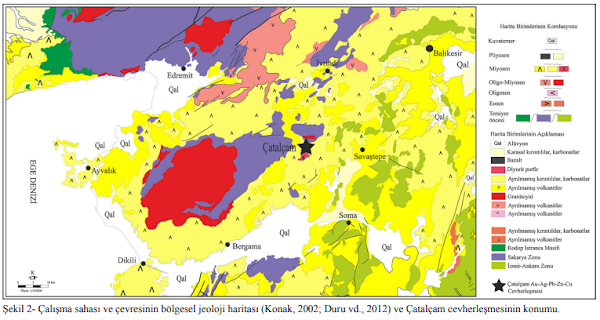The origin of platinum group minerals (PGM) in oceanic crust
Katy Evans1, Steven M. Reddy1, Renaud Merle2, Denis Fougerouse1, William D.A. Rickard3, David W. Saxey3, Jung-Woo Park4, Luc Doucet1, and Fred Jourdan1
1School of Earth and Planetary Sciences, Curtin University, GPO Box U1985, Perth, WA 6845, Australia
2Department of Earth Sciences, Uppsala University, 752 36 Uppsala, Sweden
3John de Laeter Centre, Curtin University, GPO Box U1985, Perth, WA 6845, Australia
4School of Earth and Environmental Sciences, Seoul National University, Seoul 08826, South Korea
Published online 13 April 2023 / GEOLOGY / 5 (16) Figures: (C) Harzburgite outcrop with dunite channel sampled to acquire sample MQ17-16. (D). Sample MQ17-16.
ABSTRACT
Highly siderophile elements (HSEs), including Re and Os, are used extensively as geochemical tracers and geochronometers to investigate the formation and evolution of Earth’s crust and mantle. Mantle rocks are commonly serpentinized, but the effect of serpentinization on the distribution of HSEs is controversial because HSEs are commonly hosted by rare, micrometerto sub-micrometer-scale grains of platinum group minerals (PGMs) of ambiguous origin that are challenging to identify, characterize, and interpret. In this study, atom probe tomography (APT) is used to characterize two spatially close PGM grains hosted by a partially serpentinized harzburgite from Macquarie Island, Australia. The APT data reveal an extraordinary level of detail that provides insights into the origin of a complex Cu–Pt alloy grain (average composition ∼Cu4Pt). The grain hosts Fe-, Ni-, and Pt-rich sub-grains associated with Rh, variably overlapping networks of Pd- and Cd-enrichment, and OH-rich volumes identified as fluid inclusions. Osmium and Ru are hosted by an idioblastic laurite (RuS2) grain. Compositional, textural, and phase-diagram constraints are consistent with a modified pre-serpentinization origin for the PGMs, and a comparison between observed and calculated grain distributions indicate that while Os isotope ratios were probably unaffected by serpentinization, whole-rock and grain-scale HSE and isotopic ratios may have been decoupled during serpentinization.
KAYNAK (Download Please):
https://www.researchgate.net/publication/370013781_The_origin_of_platinum_group_minerals_in_oceanic_crust
1School of Earth and Planetary Sciences, Curtin University, GPO Box U1985, Perth, WA 6845, Australia
2Department of Earth Sciences, Uppsala University, 752 36 Uppsala, Sweden
3John de Laeter Centre, Curtin University, GPO Box U1985, Perth, WA 6845, Australia
4School of Earth and Environmental Sciences, Seoul National University, Seoul 08826, South Korea
Published online 13 April 2023 / GEOLOGY / 5 (16) Figures: (C) Harzburgite outcrop with dunite channel sampled to acquire sample MQ17-16. (D). Sample MQ17-16.
ABSTRACT
Highly siderophile elements (HSEs), including Re and Os, are used extensively as geochemical tracers and geochronometers to investigate the formation and evolution of Earth’s crust and mantle. Mantle rocks are commonly serpentinized, but the effect of serpentinization on the distribution of HSEs is controversial because HSEs are commonly hosted by rare, micrometerto sub-micrometer-scale grains of platinum group minerals (PGMs) of ambiguous origin that are challenging to identify, characterize, and interpret. In this study, atom probe tomography (APT) is used to characterize two spatially close PGM grains hosted by a partially serpentinized harzburgite from Macquarie Island, Australia. The APT data reveal an extraordinary level of detail that provides insights into the origin of a complex Cu–Pt alloy grain (average composition ∼Cu4Pt). The grain hosts Fe-, Ni-, and Pt-rich sub-grains associated with Rh, variably overlapping networks of Pd- and Cd-enrichment, and OH-rich volumes identified as fluid inclusions. Osmium and Ru are hosted by an idioblastic laurite (RuS2) grain. Compositional, textural, and phase-diagram constraints are consistent with a modified pre-serpentinization origin for the PGMs, and a comparison between observed and calculated grain distributions indicate that while Os isotope ratios were probably unaffected by serpentinization, whole-rock and grain-scale HSE and isotopic ratios may have been decoupled during serpentinization.
KAYNAK (Download Please):
https://www.researchgate.net/publication/370013781_The_origin_of_platinum_group_minerals_in_oceanic_crust






Yorumlar
Yorum Gönder